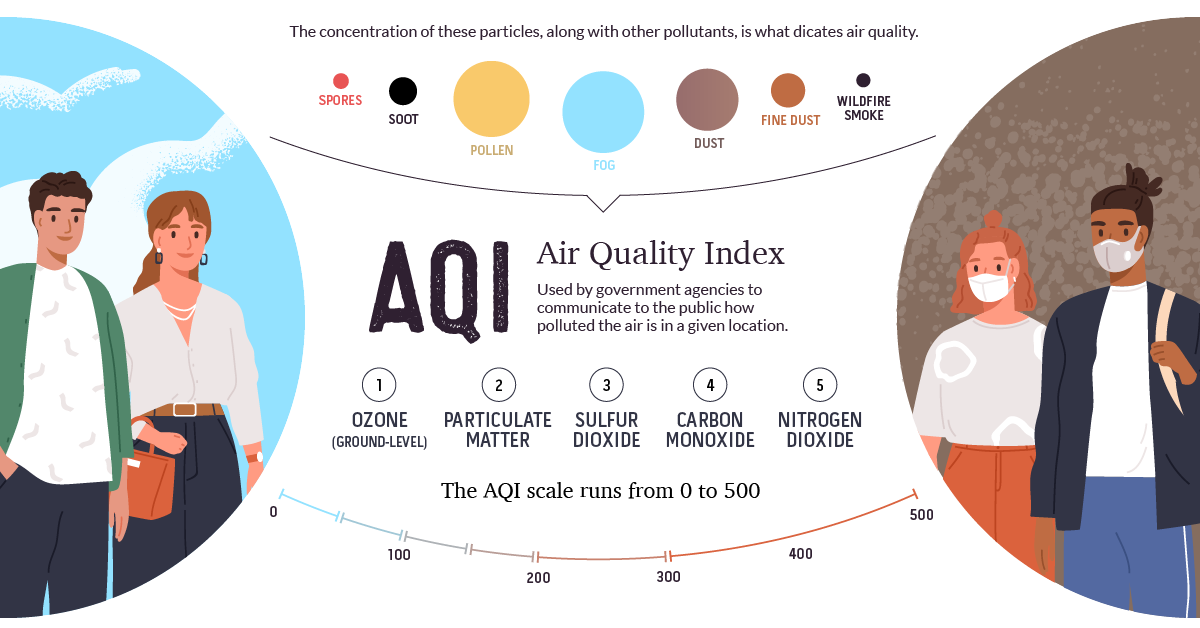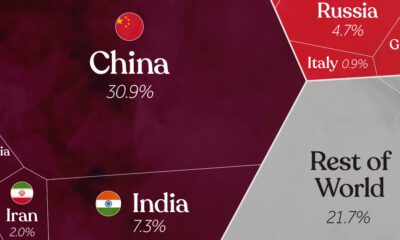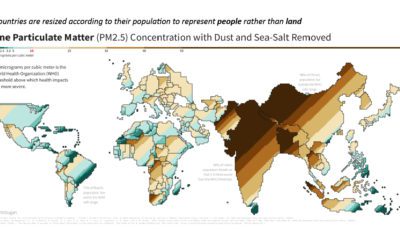Green
Understanding How the Air Quality Index Works
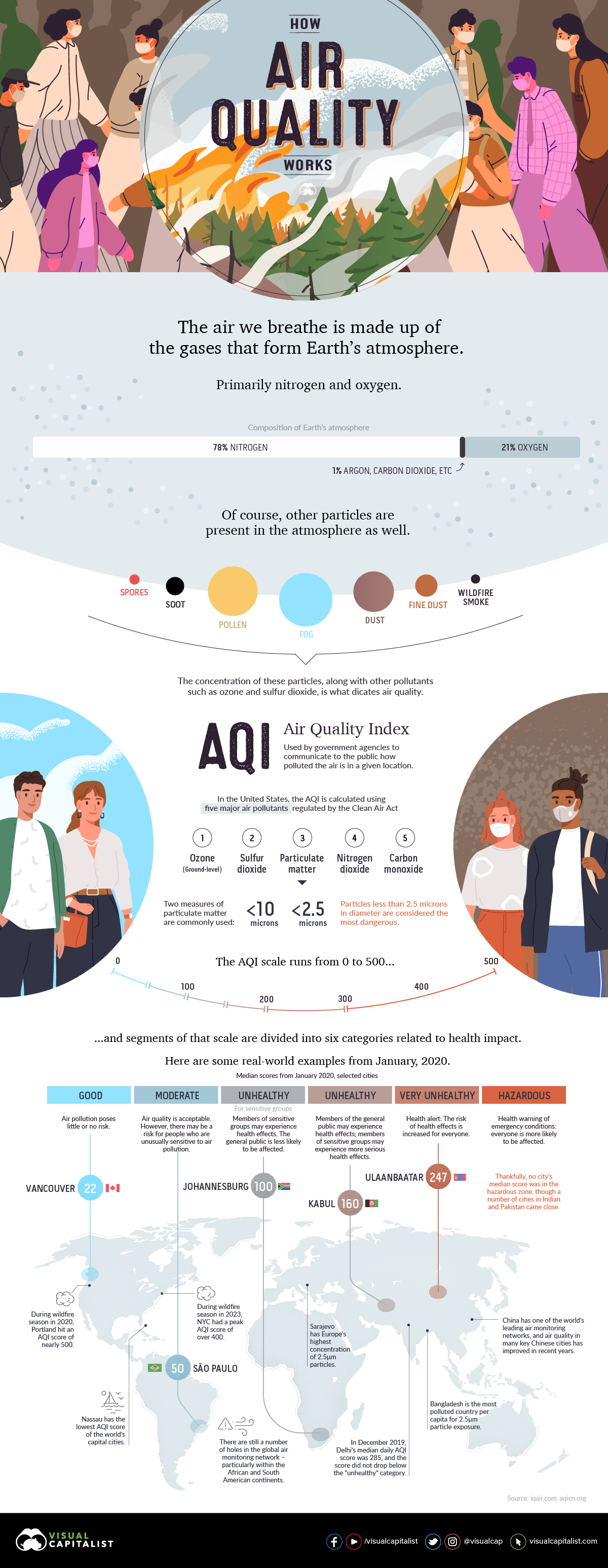
Understanding How the Air Quality Index Works
Air quality levels have received a lot of attention in recent years.
In the wake of COVID-19 lockdowns, many places reported a marked increase in air quality. Northern India captured the world’s attention when it was reported that the Himalayan mountain range was visible for the first time in decades.
On the flipside, later that summer, wildfires swept over the Pacific Northwest and California, blanketing entire regions with a thick shroud of smoke that spanned hundreds of miles.
How is air quality measured, and what goes into the health scores we see?
Measuring the Air Quality Index
When we see that air quality is “good” or “unhealthy”, those public health categories are derived from the Air Quality Index (AQI).
In the U.S., the AQI is calculated using five major air pollutants regulated by the Clean Air Act:
- Ground-level ozone
- Carbon monoxide
- Sulfur dioxide
- Particle pollution, also known as particulate matter
- Nitrogen dioxide
Some countries have a slightly different way of calculating their scores. For example, India also measures levels of ammonia and lead in the air.
To make these readings more accessible, the AQI has a scoring system that runs from 0 to 500, using data collected from air monitoring stations in cities around the world. Scores below 50 are considered good, with very little impact to human health. The higher the score gets, the worse the air quality is.
To make communicating potential health risks to the public even easier, ranges of scores have been organized into descriptive categories.
| AQI Score Range | AQI Category | PM2.5 (μg/m³) | Health Risks |
|---|---|---|---|
| 0-50 | Good | 0-12.0 | Air quality is satisfactory and poses little or no risk. |
| 51-100 | Moderate | 12.1-35.4 | Sensitive individuals should avoid outdoor activity. |
| 101-150 | Unhealthy | 35.5-55.4 | General public and sensitive individuals in particular are at risk to experience irritation and respiratory problems. |
| 151-200 | Unhealthy | 55.5-150.4 | Increased likelihood of adverse effects and aggravation to the heart and lungs among general public. |
| 201-300 | Very Unhealthy | 150.5-250.4 | General public will be noticeably affected. Sensitive groups should restrict outdoor activities. |
| 301+ | Hazardous | 250.5+ | General public is at high risk to experience strong irritations and adverse health effects. Everyone should avoid outdoor activities. |
Particulate Matter
While all the forms of atmospheric pollution are a cause for concern, it’s the smaller 2.5μm particles that get the most attention. For one, we can see visible evidence in the form of haze and smoke when PM2.5 levels increase. As well, these fine particles have a much easier time entering our bodies via breathing.
There are a number of factors that can increase the concentration of a region’s particulate matter. Some common examples include:
- Coal-fired power stations
- Cooking stoves (Many people around the world burn organic material for cooking and heating)
- Smoke from wildfires and slash-and-burn land clearing
Wildfires and Air Quality
Air quality scores can fluctuate a lot from season to season. For example, regions that are reliant on coal for power generation tend to see AQI score spikes during peak periods.
One of the biggest fluctuations occurs during wildfire season, when places that typically have scores in the “good” category can see scores reach unsafe levels. In 2020, Eastern Australia and the West Coast of the U.S. both saw massive drops in air quality during their respective wildfire seasons.
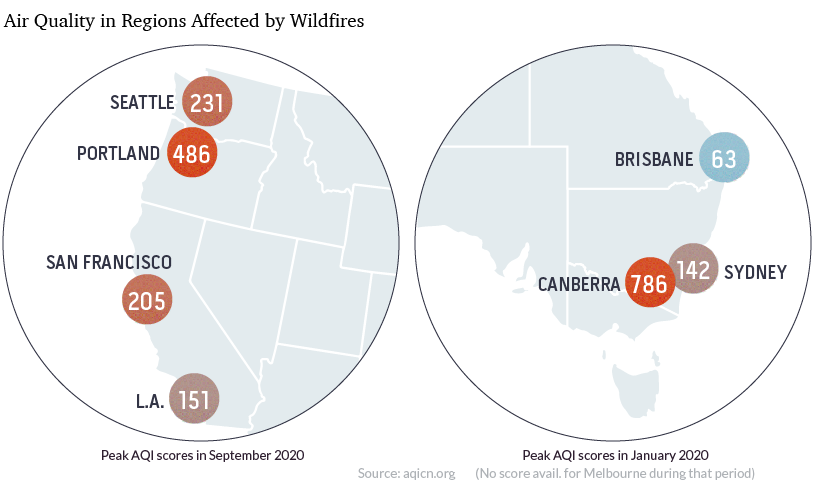
In June 2023, a storm system sent a thick blanket of smoke from Canadian wildfires down to Northeastern states, blocking out the sun and turning the sky over Manhattan into a dull shade of orange.
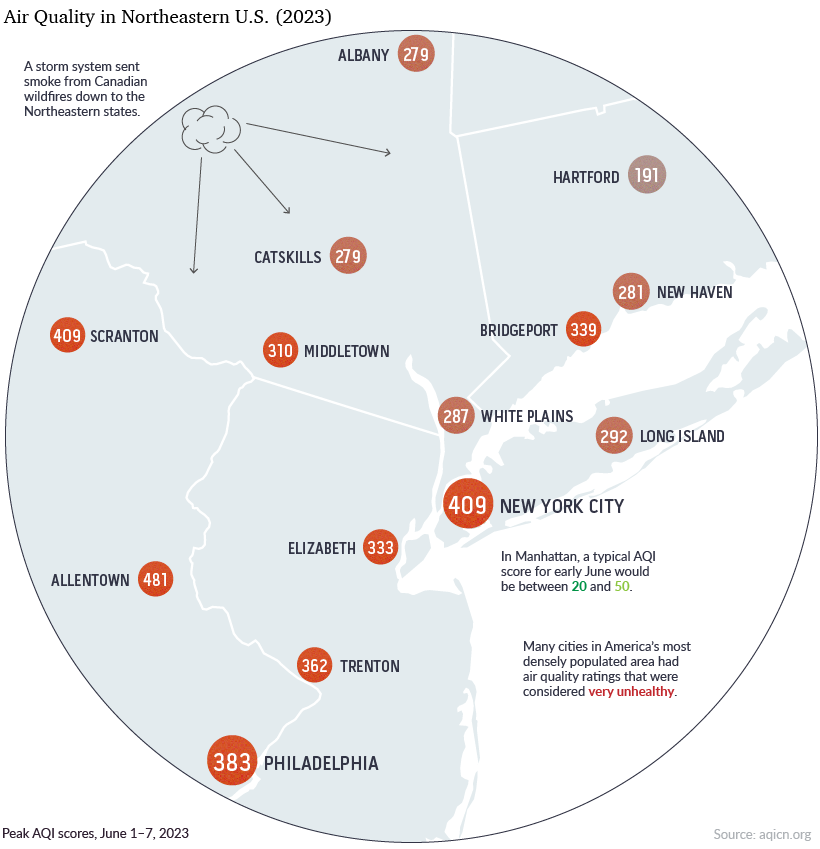
Luckily, while these types of fluctuations are extreme, they are also temporary.
Correction: Graphics and article updated to include nitrogen dioxide.
Green
How Carbon Credits Can Help Close the Climate Funding Gap
To keep a 1.5℃ world within reach, global emissions need to fall by as much as 45% by 2030, and carbon credits could help close the gap.
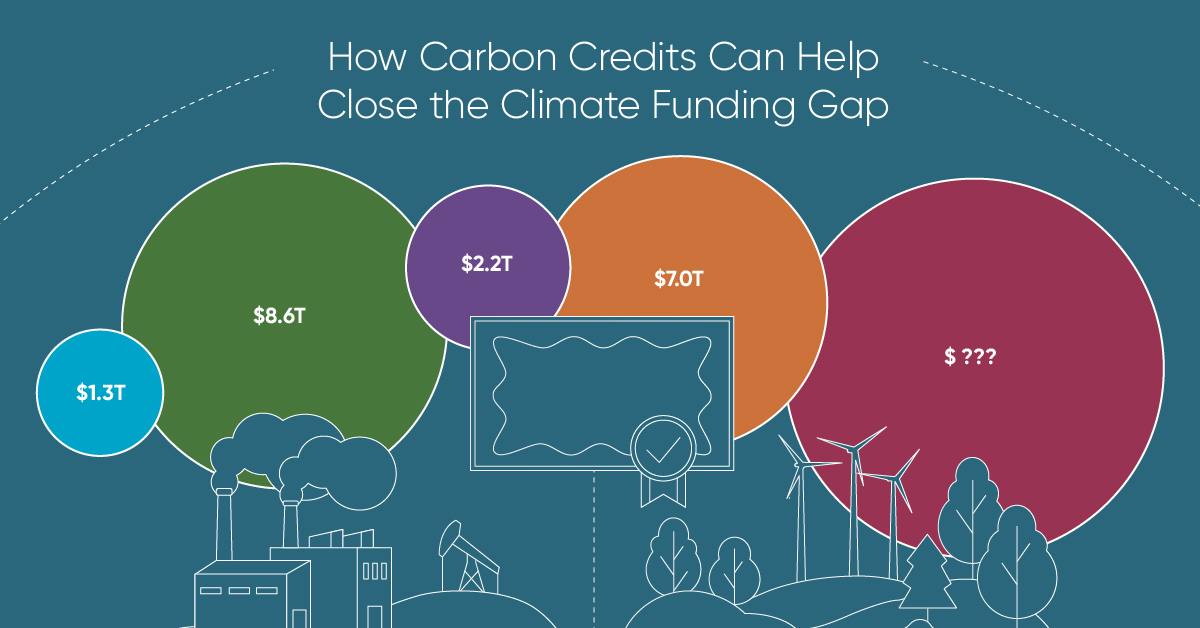
How Carbon Credits Can Help Close the Climate Funding Gap
Governments around the world have committed to the goals of the Paris Agreement, but their climate pledges are insufficient. To keep a 1.5℃ world within reach, global emissions need to fall by as much as 45% by 2030.
Bold and immediate action is essential, but so are resources that will make it happen.
In this graphic, we have partnered with Carbon Streaming to look at the role that the voluntary carbon market and carbon credits can play in closing that gap.
More Funds are Needed for Climate Finance
According to data from the Climate Policy Initiative, climate finance, which includes funds for both adaptation and mitigation, needs to increase at least five-fold, from $1.3T in 2021/2022, to an average $8.6T annually until 2030, and then to just over $10T in the two decades leading up to 2050.
That adds up to a very large number, but consider that in 2022, $7.0T went to fossil fuel subsidies, which almost covers the annual estimated outlay. And the world has shown that when pressed, governments can come up with the money, if the global pandemic is any indication.
Mobilizing Carbon Finance to the Developing World
But the same cannot be said of the developing world, where debt, inequality, and poverty reduce the ability of governments to act. And this is where carbon credits can play an important role. According to analyses from Ecosystem Marketplace, carbon credits help move capital from developed countries, to where funds are needed in the developing world.
For example, in 2019, 69.2% of the carbon credits by volume in the voluntary carbon market were purchased by buyers in Europe, and nearly a third from North America. Compare that to over 90% of the volume of carbon credits sold in the voluntary carbon market in 2022 came from projects that were located outside of those two regions.
Carbon Credits Can Complement Decarbonization Efforts
Carbon credits can also complement decarbonization efforts in the corporate world, where more and more companies have been signing up to reduce emissions. According to the 2022 monitoring report from the Science Based Targets initiative, 4,230 companies around the world had approved targets and commitments, which represented an 88% increase from the prior year. However, as of year end 2022, combined scope 1 and 2 emissions covered by science-based targets totaled approximately 2 GtCO2e, which represents just a fraction of global emissions.
The fine print is that this is just scope 1 and 2 emissions, and doesn’t include scope 3 emissions, which can account for more than 70% of a company’s total emissions. And as these emissions come under greater and greater scrutiny the closer we get to 2030 and beyond, the voluntary carbon credit market could expand exponentially to help meet the need to compensate for these emissions.
Potential Carbon Credit Market Size in 2030
OK, but how big? In 2022, the voluntary carbon credit market was around $2B, but some analysts predict that it could grow to between $5–250 billion by 2030.
| Firm | Low Estimate | High Estimate |
|---|---|---|
| Bain & Company | $15B | $30B |
| Barclays | N/A | $250B |
| Citigroup | $5B | $50B |
| McKinsey & Company | $5B | $50B |
| Morgan Stanley | N/A | $100B |
| Shell / Boston Consulting Group | $10B | $40B |
Morgan Stanley and Barclays were the most bullish on the size of the voluntary carbon credit market in 2030, but the latter firm was even more optimistic about 2050, and predicted that the voluntary carbon credit market could grow to a colossal $1.5 trillion.
Carbon Streaming is Focused on Carbon Credit Integrity
Ultimately, carbon credits could have an important role to play in marshaling the resources needed to keep the world on track to net zero by 2050, and avoiding the worst consequences of a warming world.
Carbon Streaming uses streaming transactions, a proven and flexible funding model, to scale high-integrity carbon credit projects to advance global climate action and UN Sustainable Development Goals.

Learn more at www.carbonstreaming.com.

-

 Green1 week ago
Green1 week agoRanking the Top 15 Countries by Carbon Tax Revenue
This graphic highlights France and Canada as the global leaders when it comes to generating carbon tax revenue.
-

 Green1 week ago
Green1 week agoRanked: The Countries With the Most Air Pollution in 2023
South Asian nations are the global hotspot for pollution. In this graphic, we rank the world’s most polluted countries according to IQAir.
-

 Environment2 weeks ago
Environment2 weeks agoTop Countries By Forest Growth Since 2001
One country is taking reforestation very seriously, registering more than 400,000 square km of forest growth in two decades.
-

 Green3 weeks ago
Green3 weeks agoRanked: Top Countries by Total Forest Loss Since 2001
The country with the most forest loss since 2001 lost as much forest cover as the next four countries combined.
-

 Markets2 months ago
Markets2 months agoThe World’s Top Cocoa Producing Countries
Here are the largest cocoa producing countries globally—from Côte d’Ivoire to Brazil—as cocoa prices hit record highs.
-

 Environment2 months ago
Environment2 months agoCharted: Share of World Forests by Country
We visualize which countries have the biggest share of world forests by area—and while country size plays a factor, so too, does the environment.
-

 Mining1 week ago
Mining1 week agoGold vs. S&P 500: Which Has Grown More Over Five Years?
-

 Markets2 weeks ago
Markets2 weeks agoRanked: The Most Valuable Housing Markets in America
-

 Money2 weeks ago
Money2 weeks agoWhich States Have the Highest Minimum Wage in America?
-

 AI2 weeks ago
AI2 weeks agoRanked: Semiconductor Companies by Industry Revenue Share
-

 Markets2 weeks ago
Markets2 weeks agoRanked: The World’s Top Flight Routes, by Revenue
-

 Countries2 weeks ago
Countries2 weeks agoPopulation Projections: The World’s 6 Largest Countries in 2075
-

 Markets2 weeks ago
Markets2 weeks agoThe Top 10 States by Real GDP Growth in 2023
-

 Demographics2 weeks ago
Demographics2 weeks agoThe Smallest Gender Wage Gaps in OECD Countries
